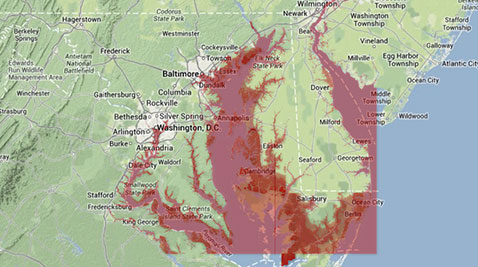WASHINGTON – The Environmental Protection Agency’s restrictions on new coal and natural gas power plants meant to reduce carbon emissions that contribute to climate change would be a disaster for western Maryland’s coal mining business, industry representatives said.
The new regulations, announced Friday by EPA Administrator Gina McCarthy, would allow new coal-powered plants to emit up to 1,100 pounds of carbon per megawatt-hour. Natural gas plants would be allowed to emit between 1,000 and 1,100 pounds of carbon per megawatt-hour, depending on their size.
“They’ll have a devastating effect on us because they want to eliminate the coal-powered plants, and all of their actions will do just that,” said Adrienne Ottaviani, the executive director of the Maryland Coal Association. “It will be probably more of the coal companies in Maryland closing their doors. They just can’t continue with the regulations being placed upon them.”
According to the latest annual report from the Maryland Bureau of Mines, mining companies employed 373 workers in Allegany and Garrett counties in 2011, producing about 3 million tons of coal that year. That number put Maryland 18th in the nation in total coal production.
But Environment Maryland, an environmental advocacy group based in Baltimore, said the regulations are necessary, as emissions from coal-powered plants are one of the chief drivers of global warming.
“In Maryland, 36 percent of our carbon emissions come from our top five power plants in the state, which is a lot,” said Talya Tavor, field associate for Environment Maryland. “And so we believe that we can do more to reduce our carbon emissions, and these standards seem to do exactly that.”
Tavor added that all of those power plants used coal as their primary fuel source.
According to a report from the state’s Climate Change Commission, global warming could be especially harmful for Maryland. The report says that by the end of the century, sea levels on Maryland’s coast could rise by two to six feet, potentially leading to real damage along the coast.
Rising ocean levels could submerge farms near the water while also forcing residents off of Smith Island in the Chesapeake Bay.
EPA Administrator McCarthy said Friday that those sorts of consequences were the primary reason behind the new regulations.
“The overwhelming judgment of science tells us that climate change is real, that human activities are fueling that change, and we must take action to avoid the most devastating consequences of climate change,” McCarthy said. “This is one of the most significant public health threats of our time.”
Currently, coal-fired power plants emit about 1,800 pounds of carbon per megawatt-hour, according to the EPA – well above the new limits. No coal-fired plants are scheduled to open in Maryland in the future.
Howard Herzog, a senior research engineer for the MIT Energy Initiative, said with these new restrictions in place, the administration is shifting the country’s focus away from coal and towards natural gas-powered plants in the future.
“What these new regulations are doing is they’re forcing coal to reduce their emissions. But natural gas doesn’t have to reduce theirs,” Herzog said. “…The way the regulations are written, where you can basically use natural gas unconstrained, where you’re going to ratchet down on what coal can do, it seems like people are just going to go to the natural gas option.”
The Maryland Coal Association’s Ottaviani said that switch will lead to fewer and fewer coal-powered plants opening in the future, leading to less demand for her industry’s resources.
“The thing that scares me the most is that Washington continues to pass legislation or regulations through the EPA that require the coal industry to achieve different levels that are not attainable,” Ottaviani said. “But the technology is not there yet to help us do that. So even if we wanted to spend all the money we had to adhere to those levels of regulations, we can’t because the technology doesn’t exist to help us get there.”
Mike Duncan, president of the American Coalition for Clean Coal Electricity, said in a statement this week that these new rules will halt development of new coal-powered plants by requiring standards that cannot be met.
“America deserves a balanced energy plan that includes continued advancements in clean coal technology, not one that crushes innovation and guarantees a diminished economic future,” Duncan said.
Developers of Maryland’s new natural gas-powered plants say they’re not worried about the new rules.
“It’s not going to affect us at all,” said Bill Pentak, a spokesman for Panda Power Funds, the Dallas-based group funding an 859-megawatt plant in Brandywine scheduled to open in 2017. “We’re using the best available control technology for the project. And as a matter of fact, we designed the plant in anticipation of this new rule as it was proposed.”
Currently, the average natural gas plant emits about 800 to 850 pounds of carbon per megawatt-hour, according to the EPA. That’s below the anticipated EPA guideline of between 1,000 and 1,100 pounds per megawatt-hour.
With even further advancements in carbon-capture technology for future plants, Pentak said emissions should be even lower.
David Hudgins, spokesman for the Old Dominion Electric Cooperative, which is constructing an approximately 1,000-megawatt plant scheduled to open in Cecil County in 2017, agreed.
“It shouldn’t affect us,” Hudgins said. “And knock on wood, creek don’t rise, we don’t anticipate any regulatory problems.”
The new EPA regulations don’t apply to existing power plants, only new plants. However, the EPA’s McCarthy said the agency is planning to release a proposal restricting emissions from current plants in June 2014.

